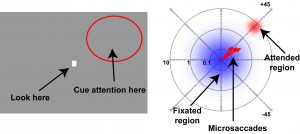
Microsaccades, or tiny microscopic saccades that we sub-consciously make when we attempt to stop our eyes from moving, have long been thought to be random occurrences. However, our work has revealed that these movements can be correlated with stimulus events that cue the allocation of covert visual attention. In other words, if you are instructed to look in one direction but covertly attend in another (by looking through your mind’s eye only), your tiny microsaccades can still be biased in the direction that you were asked to attend to. Thus, tiny microsaccades may be considered as a window into internal cognitive processes like attention.
Through a series of papers, we have studied the links between microsaccades and the cueing of attention. At the behavioral level, we have shown that microsaccades in both humans and monkeys are correlated with the allocation of visual attention. The following movie shows a demo of this phenomenon. This movie highlights the effects of cueing attention on microsaccade directions in one subject. The unit circle (gray) represents baseline microsaccade directional biases without any attentional cueing. Deviations of each quadrant from the unit circle indicate increases (larger radius) or decreases (smaller radius) in the bias of microsaccades toward this quadrant. As can be seen, cue onset first increases microsaccades toward the cue and then in the opposite direction toward a distractor item. Later on in the trials, in anticipation of a visual motion pulse onset in both the cued and distractor locations, microsaccades toward both the cue and distractor increase and those toward neither quadrant decrease, reflecting the apparent behavioral relevance of locations in the visual scene. More details about this experiment can be found in this paper.
Demo movie 1: Quicktime format.
In more recent work, we have identified a key neurophysiological mechanism mediating the above effects of cueing on microsaccades. We have specifically inactivated portions of the superior colliculus (SC), a brain structure implicated in eye movements and attention, and we have shown that such inactivation affects the ability of cues placed in the inactivated region of visual space to influence microsaccades. The following movie is the same demo movie as above, and from the same subject, but now after placing the cued stimulus in a region of visual space affected by SC inactivation. The nominal stereotypical influence of cueing and attentional instruction in the above movie is not evident here. Specifically, after cue onset by some delay, there is a strong bias toward the distractor (instead of the cue), and there are no oscillations in direction to the cue and then to the distractor. Moreover, at trial end when a motion stimulus is expected, there is no preferential increase for microsaccades toward either the cue or distractor, when compared to neither location. Thus, perturbing SC activity alters the relationship between cueing and microsaccades. More details about these results are presented in this paper.
Demo movie 2: Quicktime format.
